To use quizzes for lead generation, create engaging, interactive quizzes that require email submission for results. Focus on your audience's interests and pain points, keeping quizzes concise with 6-10 questions. Incorporate clear calls-to-action and enchanting visuals to enhance user experience and encourage sharing. Use variety, such as personality or assessment quizzes, to attract different users. Customize templates to align with your brand for a cohesive feel. Finally, track engagement metrics to refine your quizzes and boost conversion rates. There's much more to discover about optimizing quizzes for the best results.
Key Takeaways
- Interactive quizzes boost user engagement and can increase opt-in rates by an average of 55% when integrated into lead generation strategies.
- Incorporate a lead capture form at the end of the quiz to collect email addresses for result access and follow-up marketing.
- Focus on audience interests and pain points to create relevant and concise quizzes (6-10 questions) that maintain user interest.
- Use engaging visuals and multimedia elements to enhance user experience and improve conversion rates by up to 43%.
- Personalize quiz outcomes to motivate users to share results, amplifying brand visibility and generating more leads.
Overview of Lead Generation Quizzes

Lead generation quizzes are powerful tools that can transform how you engage with potential customers. These interactive quizzes not only entertain but also encourage user participation, requiring email submissions for result access. This process helps you collect information and considerably boosts lead capture and segmentation.
By integrating lead generation quizzes with your existing forms, you can see an impressive average opt-in increase of 55%, turning passive visitors into active participants. Additionally, employing techniques for continuous learning and adaptation can enhance the effectiveness of your quizzes, ensuring they resonate with your audience.
The quiz experience is designed to be engaging, allowing users to provide insights about themselves. Based on their responses, you can offer personalized recommendations that enhance their experience and build rapport. This tailored approach can lead to higher conversion rates, as potential customers feel more connected to your brand.
Moreover, quizzes often encourage social sharing, leading to increased brand visibility and higher retention rates. With successful implementation, you could achieve a remarkable 40% conversion rate from clicks to leads. This makes lead generation quizzes not just effective but essential for businesses looking to grow their customer base and boost conversions in a fun and engaging way.
Types of Lead Generation Quizzes
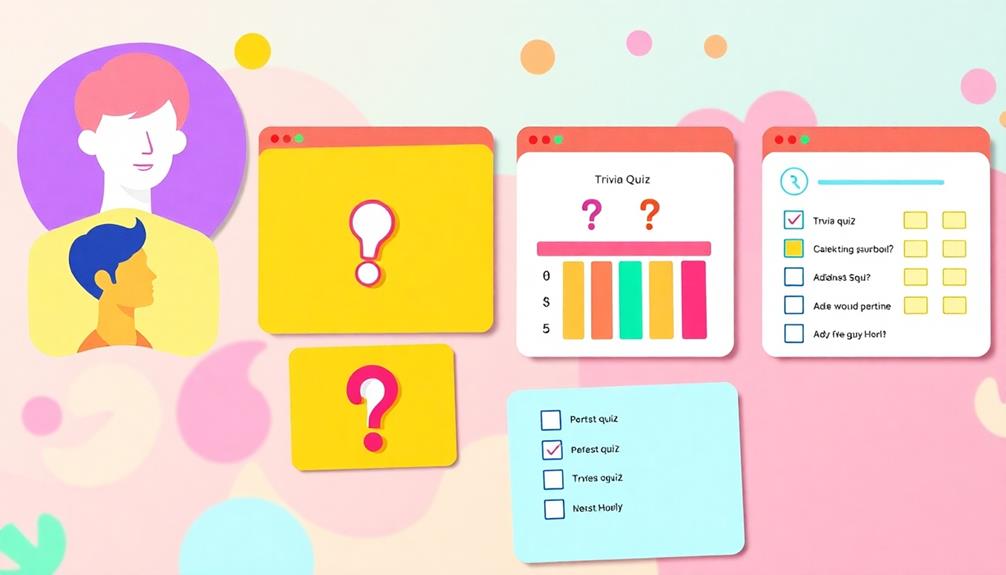
Quizzes come in various formats, each designed to engage users while capturing valuable lead information. Understanding the types of lead generation quizzes can help you choose the right one for your audience.
| Quiz Type | Purpose |
|---|---|
| Ecommerce Shop Quizzes | Provide personalized product recommendations |
| Consultation Quizzes | Simulate personalized advice and identify needs |
| Personality Quizzes | Engage users in a fun, shareable format |
| Assessment Quizzes | Evaluate skills and suggest tailored solutions |
| Survey Quizzes | Gather feedback for marketing insights |
Ecommerce Shop Quizzes focus on guiding customers toward relevant purchases, boosting conversion rates. Consultation Quizzes mimic medical symptom checkers to help users identify their needs. Personality Quizzes are enjoyable and easily shareable, increasing brand visibility. Assessment Quizzes allow you to evaluate users' specific challenges, leading to tailored solutions. Finally, Survey Quizzes collect user feedback, offering insights for better marketing strategies.
Successful Quiz Examples
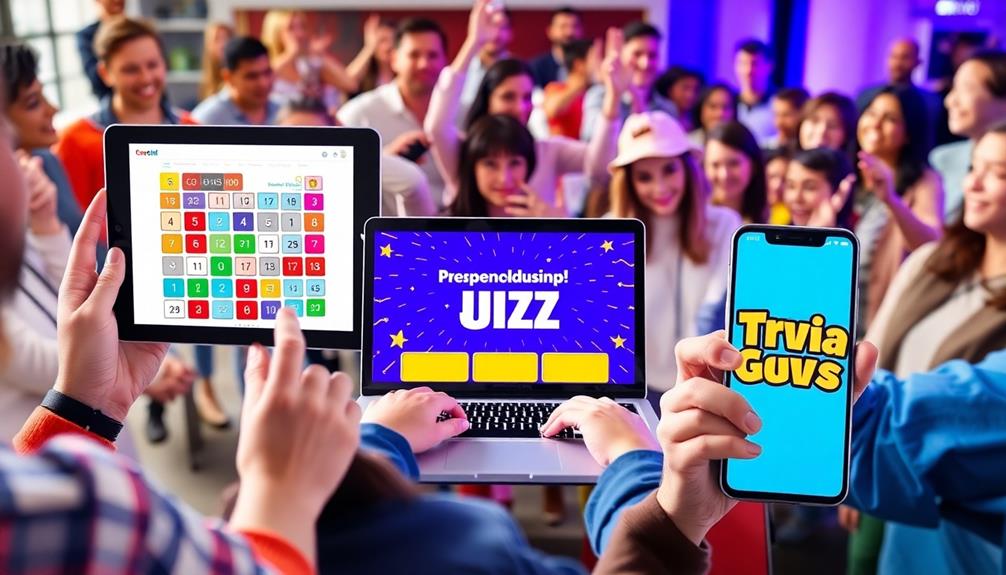
Engagement is key when it comes to successful lead generation, and several brands have mastered the art of using quizzes to captivate their audiences. For instance, Undersun Fitness employs a quiz that targets customers' fitness goals, providing personalized product suggestions along with a discount code in exchange for your contact information. This not only drives engagement but also creates a sense of urgency.
Similarly, brands that offer guidance on pet nutrition can use quizzes to educate pet owners on safe food choices, such as dogs and grapes, guaranteeing they avoid harmful items while promoting healthier alternatives.
Amelia Gray's skincare quiz takes a different approach by evaluating your skin condition and texture. By requiring an email entry to deliver tailored product insights, they ensure users feel invested in the quiz results.
Spongellé's fragrance quiz simplifies shopping for perfumes by collecting your scent preferences and making personalized recommendations based on your responses. This interactive content keeps users engaged while gathering valuable data.
BuzzFeed's personality quizzes are another fantastic example; they generate significant traffic and engagement, utilizing entertaining formats that encourage social sharing and higher completion rates.
Best Practices for Creating Quizzes

Creating quizzes that truly engage your audience is essential for effective lead generation. Focus on their interests and pain points to craft content that resonates, and make sure your quizzes are concise to keep users interested.
Incorporating elements such as clear options for accepting or rejecting cookies can enhance user experience and encourage participation.
Don't forget to include clear calls-to-action and personalized elements to enhance lead capture.
Engaging Content Creation
Crafting an effective quiz requires a keen understanding of your audience and a focus on what truly resonates with them. To boost lead generation, aim for an engaging, interactive quiz that captures attention and keeps users involved.
Consider incorporating insights from various fields, such as sleep solutions for new parents, to create relatable and helpful content. Limit your quiz to around three minutes; this encourages completion and maintains interest. Make sure your quiz questions are clear and concise, giving participants a maximum of three answers to choose from. This enhances clarity and simplifies decision-making.
Incorporating engaging visuals and multimedia elements can considerably increase lead conversion rates—up to 43% better than text-only formats. Design your quizzes to address common customer pain points, ensuring relevancy and encouraging active participation.
Effective Lead Capture Techniques
Quizzes can be a powerful tool for capturing leads when you implement effective strategies. To create a lead generation that truly resonates with your audience, consider these best practices:
1. Incorporate a Lead Capture Form: Place a lead capture form at the end of your quiz to collect their email. This simple step can boost your opt-in rates by up to 55%!
Leveraging insights from AI research and innovation can help tailor your quiz to meet audience preferences more effectively.
2. Limit Answer Choices: Keep quiz questions clear by offering a maximum of three answer options. This enhances engagement and helps participants stay focused.
3. Use Engaging Visuals: Incorporate multimedia elements and engaging visuals. Quizzes with images can convert 43% more leads than text-only versions, making your quiz more appealing.
4. Balance Questions and Results: Aim for a mix of 50% questions and 50% results. This guarantees participants receive informative and personalized outcomes, keeping them highly engaged.
Customizable Quiz Templates
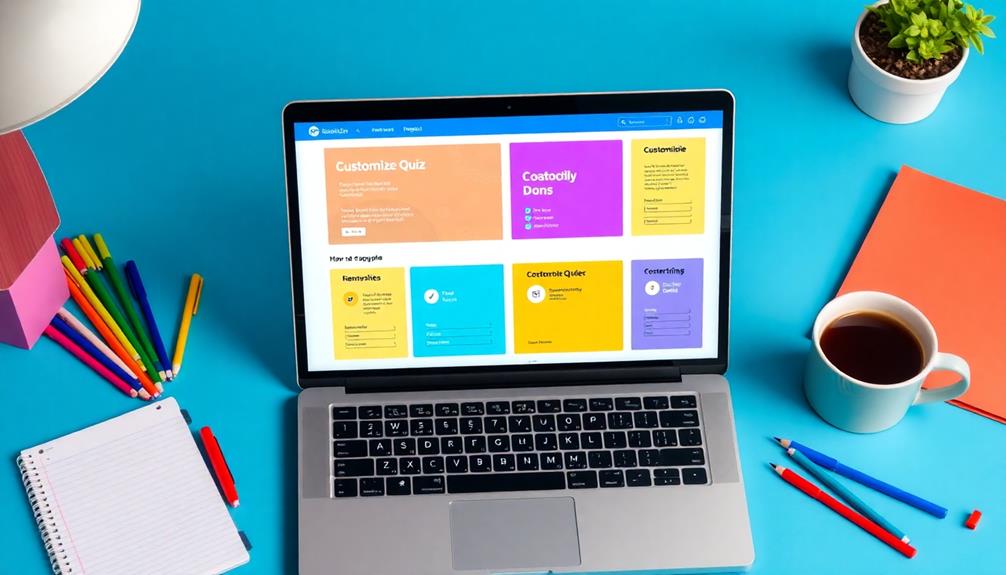
Utilizing customizable quiz templates can greatly enhance your lead generation efforts by aligning quizzes with your brand identity. These templates offer an easy way to create a quiz that resonates with your audience, ensuring a cohesive user experience that keeps them engaged.
Many platforms, like ConvertFlow and Interact, provide a variety of lead generation quiz examples that you can tailor to meet your specific business needs. Incorporating elements from website creation essentials can further enhance the effectiveness of your quizzes, ensuring they're well-optimized for both user experience and SEO.
With features like drag and drop question types and logic jumps, you can design personalized quiz paths that adapt based on user responses. This personalization considerably improves lead capture rates, making it easier to collect valuable email addresses.
In fact, quizzes designed with user preferences in mind can boost conversion rates by up to 55% when combined with existing lead forms.
To maximize engagement, regularly updating and customizing your quiz templates keeps them relevant and exciting. This not only fosters higher participation but also encourages sharing across social media platforms.
Measuring Quiz Effectiveness
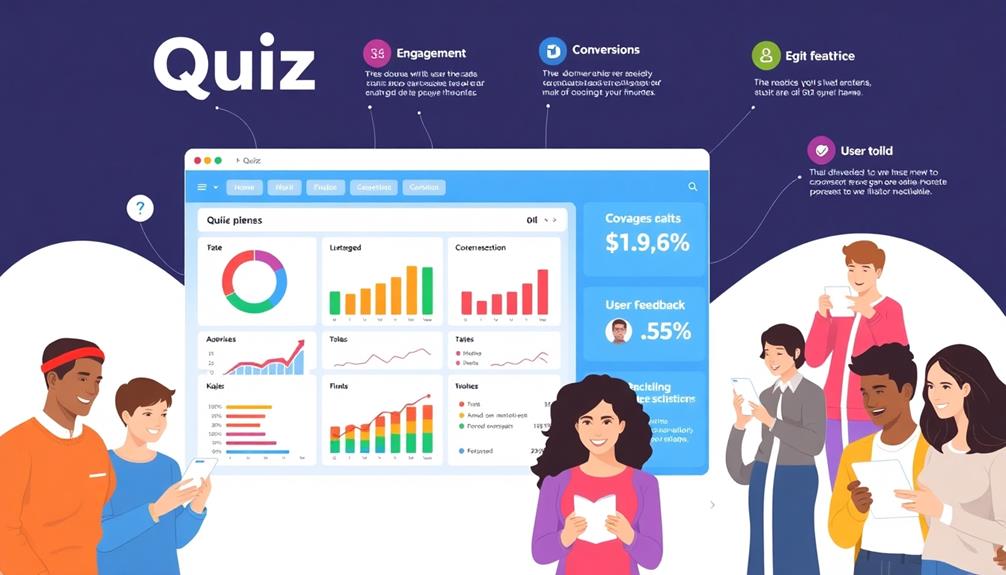
Measuring the effectiveness of your quizzes is essential for optimizing lead generation efforts. By analyzing various metrics, you can refine your approach and maximize engagement. Here are key areas to focus on:
1. Engagement Metrics: Track completion rates to gauge user engagement. Quizzes that capture interest can achieve a 40% conversion rate from clicks to leads.
Additionally, utilizing engaging activities like Hula Hoop for Weight Loss can enhance user interaction and make the quiz experience more enjoyable.
2. Conversion Monitoring: Keep an eye on post-quiz conversion rates. When quizzes are integrated with lead forms, you might see opt-in rates soar by 55%.
3. A/B Testing: Experiment with different quiz formats through A/B testing. Even minor tweaks can lead to significant improvements in generating effective leads.
4. Feedback Evaluation: Collect and analyze user feedback to continuously enhance your quizzes. This guarantees they remain relevant and engaging for your target audience.
Psychology Behind Quizzes

The psychology behind quizzes taps into your curiosity and the human need for instant feedback, transforming passive browsing into an engaging experience. When you take a quiz, you're not just answering questions; you're actively participating in a process that resonates with your desire for self-discovery.
This interactive nature often leads you to reflect on your personality and preferences, making you more inclined to submit your email for personalized results. Additionally, employing techniques such as visualization techniques can enhance your ability to create effective quizzes that resonate with your audience.
Research shows that integrating quizzes into lead generation strategies can boost average opt-in rates by an impressive 55%. Short quizzes, typically consisting of 6-10 questions, are particularly effective because they respect your time and encourage completion.
You're more likely to finish a brief, interactive quiz than a lengthy one, enhancing the chances of capturing your contact information.
Moreover, personalized outcomes not only elevate your satisfaction but also motivate you to share the quiz with friends, amplifying lead generation potential.
Crafting Effective Quizzes
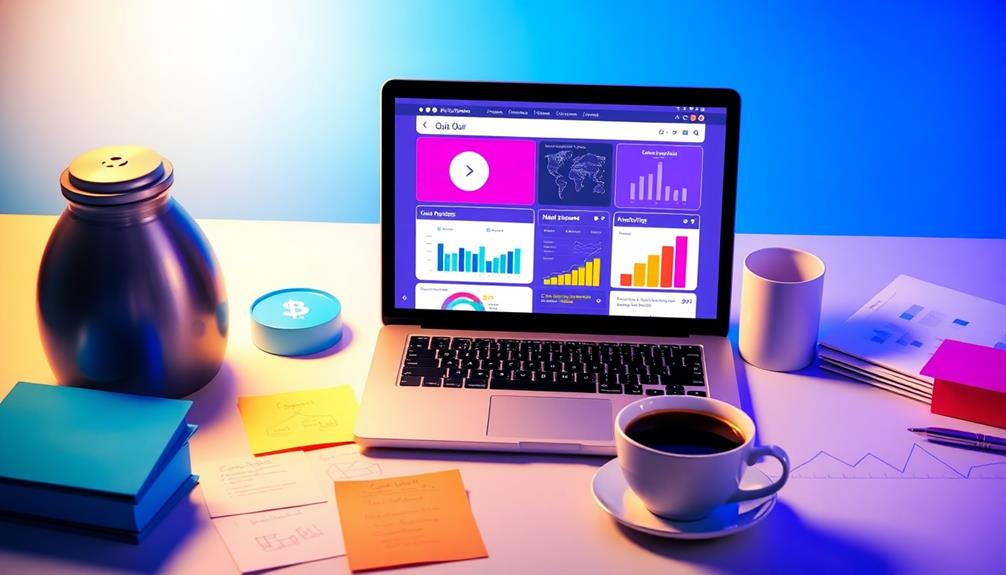
Crafting effective quizzes requires a thoughtful approach that captivates your audience from the start. To engage users and generate leads, consider these key steps:
- Engaging Title: Start with a catchy title that piques curiosity and invites participation. A well-crafted title can greatly enhance user engagement and motivate them to complete the quiz.
- Concise Format: Stick to the "three-minute rule" to keep users interested. A quick quiz encourages completion, and ensuring that users feel a sense of accomplishment can boost their confidence and willingness to engage with your content.
- Limited Options: Use a maximum of three answer options per question. This clarity helps users feel less overwhelmed and more likely to engage. By simplifying choices, you can also apply principles of emotional intelligence to better understand your audience's preferences.
- Logic Jumps: Incorporate logic jumps to tailor the quiz experience. This way, you can provide personalized recommendations based on their responses, making the quiz feel relevant and valuable.
At the end of your quiz, implement an email capture form to collect user contact information. Make sure that users see immediate value through their personalized results and recommendations.
Regularly analyze quiz performance metrics like completion rates and lead quality to refine your strategies. By focusing on user engagement, you'll optimize future quizzes for better results and conversion rates.
Enhancing Quiz Appeal

To make your quizzes more appealing, you should focus on integrating eye-catching visuals and engaging multimedia elements.
Incorporating high-quality content can greatly enhance user engagement and retention.
By crafting compelling questions that resonate with your audience, you can boost participation and keep users interested.
Visual Elements Integration
Incorporating eye-catching visuals can transform your quizzes from mundane to enchanting, greatly boosting user engagement.
When you make an effort to integrate visual elements, you not only enhance the quiz's appeal but also improve conversion rates markedly.
Here are four ways to elevate your quiz with engaging visuals:
- High-Quality Images: Use stunning images that resonate with users' personalities and interests, creating an emotional connection.
- Dynamic Videos and GIFs: Strategically embed a quiz with short video clips or GIFs to maintain a lively atmosphere, balancing around 75% images and 25% rich media.
- Emotional Eye Contact: Include images where subjects make eye contact with the camera, fostering relatability and engagement.
- Guiding Visuals: Use arrows, icons, or subtle animations to guide users through the quiz, ensuring the design complements the content effectively.
Engaging Multimedia Usage
Elevate your quiz experience by weaving in engaging multimedia elements that captivate users and keep them hooked. High-quality images can boost lead conversion rates by 43% compared to text-only quizzes, making engaging visuals a must-have. Incorporating videos and GIFs creates a dynamic experience that holds attention, leading to better quiz completion rates.
Here's a quick breakdown of effective multimedia usage:
| Multimedia Element | Impact on Engagement |
|---|---|
| High-quality Images | 43% increase in lead conversion rates |
| Videos | Enhances user retention and interaction |
| GIFs | Adds a fun element, keeping users hooked |
| Eye Contact Images | Strengthens emotional connection |
| Balanced Content | 75% images, 25% rich media for peak engagement |
Strategically placing these multimedia elements throughout your quiz not only hooks users but also encourages them to stick around. Remember, the goal is to maintain a balance between engaging visuals and concise text, ensuring the quiz remains visually stimulating without overwhelming participants. By doing so, you'll greatly improve user retention and quiz completion rates.
Compelling Question Design
Engaging users goes beyond just multimedia; the questions you ask play a pivotal role in maintaining interest and driving quiz completion.
To craft the generation quiz best suited for your audience, focus on these key elements:
- Spark Curiosity: Create questions that provoke thought and engage users on a personal level.
- Limit Choices: Keep each question to a maximum of three answer options. This clarity prevents overwhelming users, leading to a more enjoyable quiz experience.
- Incorporate Engaging Visuals: Use images alongside questions. Quizzes with visuals can convert 43% more leads than those featuring text alone.
- Address Common Customer Pain Points: Design questions that resonate with your audience's challenges. This approach guides respondents towards tailored recommendations, increasing the likelihood of email submission.
Optimizing Lead Forms

When it comes to enhancing lead forms, clarity and simplicity are key. To boost your completion rates, keep your forms concise by limiting fields to only essential questions. Research shows that forms with fewer fields can lead to a 20-30% increase in opt-in rates.
Consider using flexible fields that allow for enhanced data collection without overwhelming users; this strikes a balance between gathering necessary information and maintaining user interest.
Don't underestimate the power of a clear and compelling call-to-action (CTA). A strong CTA within your lead forms encourages users to submit their email addresses, greatly increasing the likelihood of conversion.
A/B testing different form lengths and structures can also help you identify what resonates with your target audience. By experimenting with variations, you can find the ideal balance that leads to higher conversion rates.
Frequently Asked Questions
How to Generate Leads With Quiz?
To generate leads with quizzes, create engaging content that requires email submission for results. Promote it on social media, use visuals, and implement logic jumps to personalize user experiences and boost participation.
How to Use a Quiz as a Lead Magnet?
You can use a quiz as a lead magnet by crafting engaging questions that resonate with your audience. Offer personalized results in exchange for their email, creating an incentive for them to participate and share their information.
How Can Quizzes Boost Lead Capture?
Quizzes boost lead capture by engaging users, making them active participants. When you require email submissions for personalized results, you not only gather valuable leads but also enhance user experience, driving higher conversion rates and brand visibility.
What Is a Lead Quiz?
A lead quiz's an interactive tool that engages you through questions, helping capture your preferences and needs. It offers personalized recommendations while collecting your email for future communication, enhancing your overall experience and connection.
Conclusion
Incorporating quizzes into your lead generation strategy can transform your approach, turning cold prospects into engaged leads. Just like a key opening a door, a well-crafted quiz reveals a world of insights and connections. By understanding your audience and applying best practices, you can create an irresistible experience that resonates. So, immerse yourself in the world of quizzes—your next great lead is just a question away!










